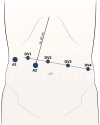Can robotic gastric bypass be considered a valid alternative to laparoscopy? Our early experience and literature review
- PMID: 38375411
- PMCID: PMC10875057
- DOI: 10.3389/fsurg.2024.1303351
Can robotic gastric bypass be considered a valid alternative to laparoscopy? Our early experience and literature review
Abstract
Background: Robotic bariatric surgery serves as an alternative to laparoscopy. The technology provides the surgeon with an accurate three-dimensional view, allowing complex maneuvers while maintaining full control of the operating room.
Hypothesis: We report our experience with this innovative surgery compared with laparoscopy during Roux-en-Y gastric bypass to demonstrate its safety and feasibility. The aim of this study is to evaluate potential differences between the robotic and laparoscopic techniques.
Materials and methods: Our study retrospectively identified 153 consecutive obese patients who underwent either laparoscopic or robotic gastric bypass (RGB) procedures over a 2-year period at the Department of Medical and Surgical Sciences, University of Foggia. Data on demographics, operative time, conversion rate, length of hospital stay, and mortality were collected and compared between two groups of patients: 82 patients who underwent laparoscopic procedures and 71 who underwent robotic procedures.
Results: We analyzed 153 patients who underwent gastric bypass with a mean age of 42.58 years, of whom 74 were female; 71 were treated with a robotic approach and 82 with a laparoscopic approach. The mean operative time was 224.75 ± 10.4 min for RGB (including docking time) and 101.22 min for laparoscopic gastric bypass (LGB) (p < 0.05), which is statistically significant. The median length of stay was 4.1 days for the RGB group and 3.9 days for the LGB group (p = 0.89). There is only one conversion to laparoscopy in the RGB group. We observed only one case of postoperative complications, specifically one episode of endoluminal bleeding in the laparoscopic group, which was successfully managed with medical treatment. No mortality was observed in either group.
Conclusion: The statistical analysis shows to support the robotic approach that had a lower incidence of complications but a longer operative duration. Based on our experience, the laparoscopic approach remains a technique with more haptic feedback than the robotic approach, making surgeons feel more confident.This study has been registered on ClinicalTrial.gov Protocol Registration and Results System with this ID: NCT05746936 for the Organization UFoggia (https://clinicaltrials.gov/ct2/show/NCT05746936).
Keywords: Roux-en-Y gastric bypass; bariatric surgery; da Vinci robot®; laparoscopic surgery; robotic bariatric surgery.
© 2024 Pavone, Pacilli, Gerundo, Quazzico, Ambrosi and Tartaglia.
Conflict of interest statement
The authors declare that the research was conducted in the absence of any commercial or financial relationships that could be construed as a potential conflict of interest.
Figures
References
Associated data
LinkOut - more resources
Full Text Sources
Medical
Research Materials






